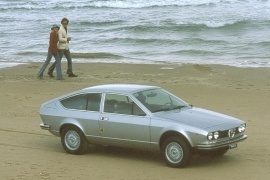Alfa Romeo introduced the Alfetta in 1972 and, two years later, the carmaker introduced the fastback coupe version for it, the GT.
It was the beginning of a beautiful motorsports page.
The name came from a Formula 1 car from the ’50s, and Alfa Romeo tried, and succeeded, to make a successful sports-car. Its main improvements were the transaxle system, with the engine at the front and the gearbox in the rear for better weight distribution. It moved the rear disc brakes up on the gearbox, not on the wheels like any other car on the market, to reduce unsprung masses.
To create the car, Alfa Romeo employed Ital Design Studio, which made a timeless design. Its double headlights front were mounted slightly behind the hood’s front edge while the black grille sported the big Alfa Romeo shield in the middle. The slim, chromed metallic front bumper featured a rubber strip and, right above it, Giugiaro installed the turn-signals and the stationary lamps. From its sides, the flush door handles showed the carmaker’s effort to improve the aerodynamic. The carmaker installed wide rear windows on the sides, with a split design and a vertical slat.
Inside, the Alfetta GT featured a very unusual design for the dashboard. The carmaker installed only the tachometer into a square cluster in front of the driver, while the rest of the dials and gauges were mounted on a separate instrument panel in the middle of the dashboard. Its sport bucket seats at the front featured high-bolstering to provide better side support and wide headrests. In the back, the bench was deep-profiled for two adult passengers.
Under the hood, Alfa Romeo installed a 1.6-liter engine. Later on, in 1976, it introduced a new, 2.0-liter engine for the Alfetta GTV version.

























































